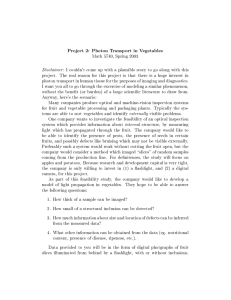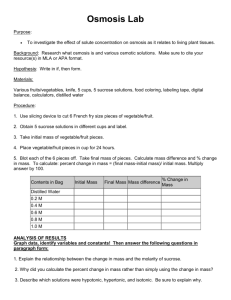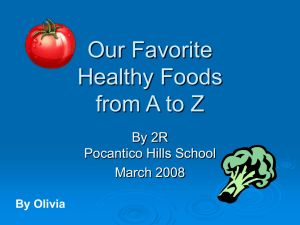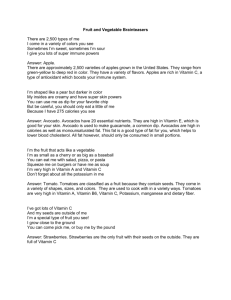Estimation of fruit and vegetable intake using
advertisement
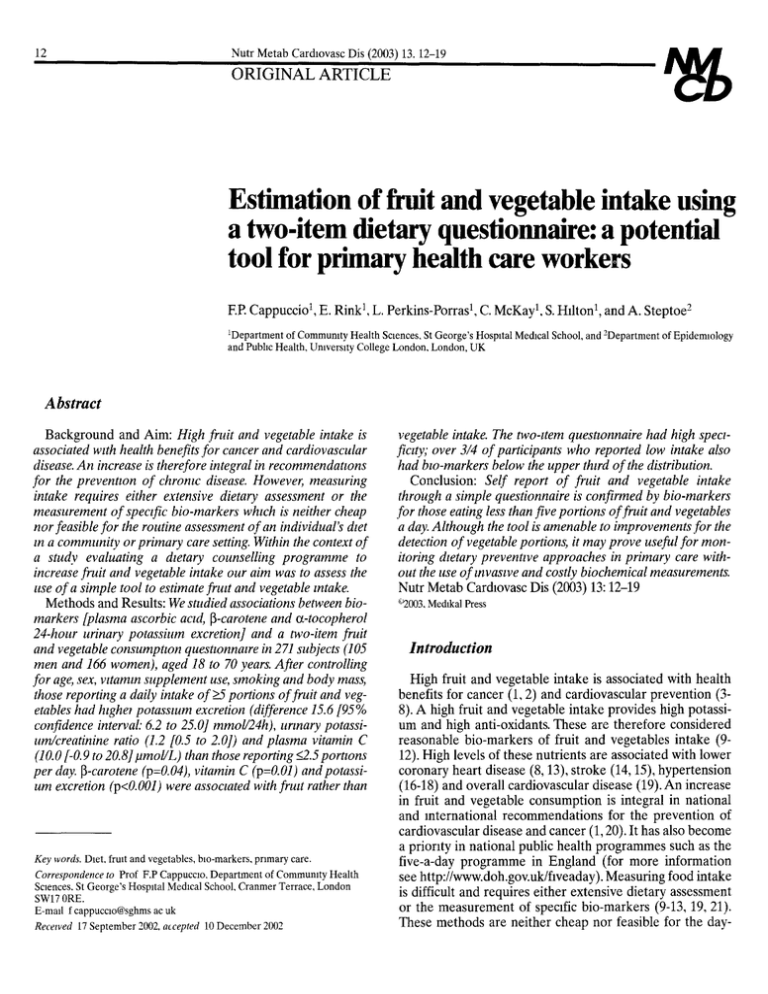
12
Nutr Metab Cardlovasc Dis (2003) 13.12-19
ORIGINAL ARTICLE
Estimation of fruit and vegetable intake using
a two-item dietary questionnaire: a potential
tool for primary health care workers
EP. Cappuccio1, E. Rink 1, L. Perkins-Porras1, C. McKay1, S. Hilton 1, and A. Steptoe 2
1Department of Community Health Sciences. St George's Hospital Medical School, and 2Department of Epidemlology
and Public Health, University College London, London, UK
A bstract
Background and Aim: High fruit and vegetable intake is
associated wtth health benefits for cancer and cardiovascular
disease. An increase is therefore integral in recommendattons
for the prevention of chromc disease. However, measuring
intake requires either extensive dietary assessment or the
measurement of spectfic bio-markers whtch is neither cheap
nor feasible for the routine assessment ofan individual's dtet
m a community orprimary care setting. Within the context of
a study evaluating a dtetary counselling programme to
increase fruit and vegetable intake our aim was to assess the
use of a simple tool to estimate frutt and vegetable retake.
Methods and Results: We studied associations between biomarkers [plasma ascorbic actd, B-carotene and c~-tocopherol
24-hour urinary potassium excretion] and a two-item fruit
and vegetable consumptton questtonnatre in 271 subjects (105
men and 166 women), aged 18 to 70 years. After controlling
for age, sex, vttamm supplement use, smoking and body mass,
those reporting a daily intake of >_5portions of fruit and vegetables had htghel potasstum excretion (difference 15.6 [95%
confidence intervak 6.2 to 25.0] mmol/24h), urmary potassium/creatinine ratio (1.2 [0.5 to 2.0]) and plasma vitamin C
(10. 0 [-0.9 to 20.8] ~tmol/L ) than those reporting <_2.5porttons
per day. B-carotene (p=O.04), vitamin C (p=O.O1) and potassium excretion (p<O.O01) were assoctated with fruit rather than
Key words. Diet, fruit and vegetables, blo-markers, primary care.
Correspondence to Prof F.P Cappucclo, Department of Commumty Health
Sciences, St George's Hospital Medical School, Cranmer Terrace, London
SW17 ORE.
E-marl f cappuccio@sghms ac uk
Recetved 17 September 2002, accepted 10 December 2002
vegetable intake. The two-ttem questtonnaire had high speclficay; over 3/4 of participants who reported low intake also
had blo-markers below the upper thtrd of the distribution.
Conclusion: Self report of fruit and vegetable intake
through a simple questionnaire is confirmed by bio-markers
for those eating less than five portions or fruit and vegetables
a day. Although the tool is amenable to improvements for the
detection of vegetable portions, it may prove useful for monitoring dtetary preventtve approaches in primary care without the use of mvastve and costly biochemical measurements.
Nutr Metab Cardlovasc Dis (2003) 13:12-19
~2003, Medlkal Press
Introduction
High fruit and vegetable intake is associated with health
benefits for cancer (1, 2) and cardiovascular prevention (38). A high fruit and vegetable intake provides high potassium and high anti-oxidants. These are therefore considered
reasonable bio-markers of fruit and vegetables intake (912). High levels of these nutrients are associated with lower
coronary heart disease (8, 13), stroke (14, 15), hypertension
(16-18) and overall cardiovascular disease (19). An increase
in fruit and vegetable consumption is integral in national
and international recommendations for the prevention of
cardiovascular disease and cancer (1, 20). It has also become
a priority in national public health programmes such as the
five-a-day programme in England (for more information
see http://www.doh.gov.uk/flveaday). Measuring food intake
is difficult and requires either extensive dietary assessment
or the measurement of specific bio-markers (9-13, 19, 21).
These methods are neither cheap nor feasible for the day-
13
Assessment of fruit and vegetable intake in pnmary care
to-day monitoring of dietary changes in a community setting or in primary care. The National Health Service Plan
makes a commitment to the development of a national programme to increase fruit and vegetable consumption, particularly in low-income groups (22) who eat much less fruit
and vegetables (23). As part of this programme, action
includes evaluation and monitoring.
In the context of a study evaluating a behaviourallyoriented dietary counselling programme designed to
increase fruit and vegetable intake, we took the opportunity to assess a simple dietary questionnaire to estimate fruit
and vegetable intake in an inner city primary care setting.
Methods
Data were collected in the context of a randomised parallelgroup controlled comparison of behaviourally orientated
dietary counselling and informational counselling in primary
care (24). The study is based in one general practice in South
London. Details of the study participants and their recruitment are given elsewhere (24). This paper reports on the characteristics of the 271 participants who took part in the trial.
There were 105 men and 166 women, 192 were white, 71
of black African origin and eight of other ethnic groups.
Only six (2%) of them were on thiazide diuretics. All subjects underwent a baseline assessment, a general questionnaire and a blood test as early in the morning as possible to
minimise diurnal variation in bio-markers. They were also
asked to provide a 24-hour urine collection. Physical assessment included body weight (bare footed in light indoor
clothing on electric scales), height, waist and hip measurements so that body mass index (BMI) and waist/hip ratio
(WHR) could be calculated. Blood pressure was measured
after 10 minutes in the sitting position with three consecutive readings using an automated device.
Usual fruit and vegetable consumption was assessed by a
two-item food-frequency questionnaire originally devised by
Wardle et al (25). This was sent to all participants prior to the
visit for self-completion at home. The questions used to assess
the amount of fruit and vegetable consumption were: How
many pieces of fruit, of any sort, do you eat on a typical day?
How many portions of vegetables, excluding potatoes, do you
eat on a typical day? Portion size was defined using The
British Dietetic Association guidelines ('Give me Five'; Fact
sheet 5, 1998 http://www.bda.uk.com/) with examples given
(eg an apple or banana, a small bowl of strawberries, three
tablespoons of tinned pears). When necessary, the nurse clarified the meaning of portion size for specific items. Fruit juice
was included in 'pieces of fruit' if it was at least a glass of flesh
juice in a day. Even if more than one glass per day was reported, they would only count as one portion of fruit per day.
Potatoes did not count towards the portions of vegetables.
Portions of fruit and vegetables were then pooled and the
combined vanable was used for the main analysis both as a
continuous variable and after classification in tertiles.
The general questionnaire provided information about
smoking and regular use of vitamin supplements (26), used
in the analysis as potential confounders.
Non-fasting venous blood samples were taken and analysed
to determine plasma ascorbic acid (vitamin C), mtocopherol
(vitamin E) and [3-carotene. For vitamin C determination,
blood was collected in citrate, protected from light, cold spun
and plasma added to 10% metaphosphoric acid (MPA).
Samples were stored at -70°C until analysis. Plasma vitamin C
was estimated using a fluorimetric assay (27).Vitamin E and [3carotene were measured concurrently by normal phase high
performance liquid chromatography (HPLC) (28).
Twenty-four-hour urinary potassium excretion has been
used as a measure of dietary potassium intake, the vast
majority of which comes from fruit and vegetables (16, 29).
Participants were given oral and written instructions on how
to collect a complete 24-hour urine specimen. The completeness of the collection was then checked by direct
enquiry and by the evaluation of creatinine and volume outputs. Two-hundred and twenty-one (or 82%) samples were
deemed complete and were used in the analysis. Sodium,
potassium, calcium and creatinine were measured by standard methods. Excretion was expressed both as absolute
daily excretion and as ratio to creatinine output.
The study was approved by the local Ethics Committee and
each participant gave written informed consent to take part.
Data are reported as mean, standard error or 95 % confidence
intervals. Associations between variables were measured by
Spearman's rank correlation and by analysis of co-variance
(ANCOVA) for linear trends and by multiple regression
analysis for each bio-marker, with assessment of fruit and/or
vegetable intake as the independent variable(s), and potential
confounders as covariates. A p value less than 0.05 was considered statistically significant.The analyses were not different
when excluding six participants on thiazide diuretics.
Results
Characteristics of the partictpants
Men were older than women (48.4 [SD 13.4] vs 40.0 [13.2]
years, p<0.001) so that further comparisons are age-adjusted
14
F.P. Cappucclo, et al
Women (n=166)
Men (n=105)
p
Height (cm)
162.4 (0 5)
174 2 (0.6)
<0.001
Weight (Kg)
67.4 (1.2)
79.2 (1.5)
<0 001
Body mass index (Kg/m 2)
25.6 (0 4)
26 0 (0 5)
0.54
Waist orcumference (crn)
79 6 (0.9)
89.4 (1 1)
<0.001
Hip circumference (cm)
102 1 (0.8)
101.6 (1.0)
0.73
Waist/hip ratio
0.783 (0.006)
0 885 (0.008)
<0 001
Cigarette smokers (%)
29 (22 to 36)
43 (34 to 53)
0 025
Vitamin supplement takers (%)
34 (26 to 42)
30 (21 to 40)
0 58
TABLE 1
Characteristics of the participants.
Results are mean (SE) or % (95%CI) adjusted for age
(Table 1). Men had BMI comparable to women (difference:
0.4 [95% CI: -0.9 to 1.7] kg/m2, p=0.54), and higher WHR
(difference 0.103 [0.008 to 0.123], p<0.001). Men were more
likely to smoke (Table 1). Gender did not affect reported
intake of fruit and vegetables (Table 2) and this was reflected in comparable plasma levels of vitamin C, vitamin E and
~l-carotene. However, urinary bio-markers indicate higher
levels of sodium and potassium excretion in men than
women, so further analyses were carried out also after
adjustment for sex.
associated with fruit and vegetable intake and
bio-markers
Factors
Compared to non-smokers, smokers reported less fruit
and vegetable intake (age and sex-adjusted difference: 0.9
[0.4 to 1.3] portions per day, p=0.001) and had significantly
Women (n=166)
Men (n=105)
1.8 (0 1)
1.8 (0.1)
3.6 (0.1)
1.8 (0 1)
1.9 (0.1)
3.7 (0 2)
0 95
0 38
0.62
79 9 (2 8)
26,7 (0.9)
1.18 (0.06)
72 9 (3 4)
261 (1 1)
1.01 (0.08)
0.13
0 69
0.10
Portions per day of
Fruit intake
Vegetable intake
Fruit and vegetable intake
Plasma
Vitamin C (pmol/L)
Vitamin E (pmol/L)
~-carotene (pmoVL)
Urine
Volume (ml)
Sodium (mmoV24h)
Potassium (mmol/24h)
Calcium (mmoV24h)
Creatmlne (mmol/24h)
Sodlum:creatmme
Potass~um-creatmine
Calc~um:creatinme
Results are mean (SE)adjusted for age
(n= 130)
(n=91)
1734 (82)
138 (5)
67 (2)
3.9 (0.2)
98(0.3)
14.3(04)
7.1 (0.2)
0 43 (0.02)
1955 (98)
164 (6)
83 (3)
4.2 (0.3)
15.0 (0.4)
11.3 (0,5)
5 7 (0 2)
0 29 (0.02)
0.09
0.003
<0.001
0.44
<0.001
<0.001
<0.001
<0.001
TABLE 2
Fruit and vegetable intake, plasma
and urinary bio-markers in women
and men.
Assessment of fruit and vegetable intake in primary care
15
Smokers (n=91)
Non-Smokers (n=179)
p
Height (cm)
Weight (Kg)
Body mass index (Kg/m 2)
Waist circumference (cm)
Hip circumference (cm)
Waist/hip ratio
167.0 (0.7)
703(1 5)
25.2 (0.5)
82.4 (1.2)
100 9 (1 0)
0.833 (0.008)
167 0 (0.5)
72.9(1 1)
26 1 (0.4)
83.9 (0 8)
102.4 (0.7)
0 817 (0.006)
0 96
0.18
0 21
0.32
0.22
0.13
Vitamin supplement takers (%)
Portions per day of
Fruit and vegetable intake
25 (15 to 34)
34 (26 to 41)
0 15
3.1 (0 2)
3.9 (0.1)
0.001
69.0 (3.5)
29 0 (1.1)
0 98 (0.08)
82.3 (2.5)
25 0 (0.8)
1 17 (0.06)
0 002
0.004
0.054
(n=71)
(n=15o)
1760 (109)
140 (7)
67 (3)
4.0 (0 3)
10 8 (0.4)
13 5 (0.5)
6.5 (0 3)
0.40 (0.03)
1855 (75)
153 (5)
77 (2)
4 1 (0 2)
12.5 (0.3)
12 9 (0.4)
6.6 (0.2)
0 36 (0 02)
TABLE 3
Characteristics of smokers and nonsmokers.
Plasma
Vitamin C ~moi/L)
Vitamin E ~mol/L)
~-carotene ~mol/L)
Urine
Volume (ml)
Sodium (mmol/24h)
Potassium (mmoV24h)
Calcium (mmol/24h)
Creatinlne (mmol/24h)
Sodium:creatinine
Potasslum:creatlnme
Calcium:creatinine
0.48
0.14
0 006
0.83
0.001
0 33
0 82
0.25
Resultsare mean(SE)or % (95% CI) adjustedfor age and sex One missingvalue
lower levels of plasma vitamin C (13.3 [4.7 to 21.8] pmol/L
p=0.002), vitamin E (3.9 [1.2 to 6.6] ~tmol/L,p=0.004), 13carotene (0.19 [0 to 0.38] ~tmol/L, p=0.05), and urinary
potassium (10 [3 to 17] mmol/day, p=0.006), but not urinary
sodium (13 [-4 to 30] mmol/day, p=0.14) excretion (Table
3). Participants who made regular use of vitamin supplements (n=77) had significantly higher levels of both plasma
vitamin C (age and sex-adjusted difference: 9.7 [0.9 to 18.6]
~tmol/L, p=0.03) and vitamin E (2.8 [-5.7 to 9.4] lamol/L,
p=0.06), but not ~-carotene (1.4 [-0.2 to 0.2] ~tmol/L,
p=0.99) or urinary potassium excretion (5 [-3 to 13]
mmol/day,p=0.17).
Relationship between fruit and vegetable intake and
bio-markers
There was a direct relationship between the reported
daily intake of fruit and vegetable and urinary potassium
excretion both expressed as total daily excretion (Spearman
rs=0.234, p<0.001) and as potassium/creatinine ratio
(rs=0.184, p=0.006). Also the level of fruit and vegetable
intake was directly associated with plasma levels of vitamin
C (rs=0.133, p=0.029), but not vitamin E (rs=0.018, p=0.77)
or I]-carotene (rs=0.085,p=0.16). This relationship is shown
m Table 4, after controlling for the confounding effects of
age, sex, vitamin supplement, smoking and BMI. Increasing
numbers of portions of fruit and vegetables consumed per
day were significantly associated with higher levels of urinary potassium excretion and plasma levels of vitamin C.
However, when the reported intakes of fruit and vegetable
were analysed separately, fruit intake (but not vegetable
intake) correlated with plasma levels of 13-carotene
(p=0.04), vitamin C (p=0.01), and with urinary potassium
excretion (p<0.001) (Table 5).
Specificity and sensitivity
The questionnaire on fruit and vegetables had low sensitivity. Only 36% (27/76) of those who were in the upper tertile of reported fruit and vegetable intake (five or more por-
F P. Cappuccio, et al
]6
TABLE 4
Measure of fruit and vegetable intake, assocmtion between blo-markers and dietary questionnaire.
Variable
Fruit and vegetables retake
(portions per day)
Pieces of fruit (of any sort) &
vegetables (excluding potatoes) per day
p value
Difference
III vs I tertile
_<2 5 per day
(n=82)*
3 0-4.5 per clay
(n=105)*
_>5 0 per day
(n=58)*
1 8 (0 1)
3 6 (0,1)
6 3 (0A)
<0 001
4 5 (4,2 to 4.8)
68 2 (3 5)
26 7 (1 2)
1 12 (0 08)
81.3 (3.1)
26.5 (1 0)
1 10 (0.07)
78 2 (4.2)
26.3 (1.4)
1 16 (0 10)
0 036
0 79
0 77
10 0 (-0 9 to 21 0)
-0 47 (-4 12 to 3 18)
0.05 (-0 21 to 0.31)
(n=68)
(n=91)
(n=49)
151 7 (7 3)
67 9 (3 0)
3 78 (0 29)
11 7 (0 4)
13 4 (0.5)
6 1 (0,2)
0.35 (0.03)
153.1 (6 4)
71.5 (2 6)
4 23 (0 25)
11 7 (0.3)
13 7 (0 5)
6 4 (0.2)
0 40 (0 02)
140.2 (8,9)
83 5 (3 6)
4 04 (0 35)
12 3 (0 5)
12 2 (0 7)
7 3 (0 3)
0 36 (0.03)
0.38
0 002
0 47
0 35
0 23
0 003
0 65
-11 6 (-34 6 to 11 4)
15.6 (6 2 to 25 0)
0 26 (-0 64 to 1,17)
0.62 (-0.56 to 1 81)
-1.23 (-2.95 to 0 50)
1 25 (0 47 to 2.03)
0 01 (-0 07 to 0.09)
Plasma
Vitamin C (~tmol/L)
V~tam~n E (#mol/L)
i%carotene (umol/L)
Urine
Sod=um (mmol/24h)
Potassium (mmol/24h)
Calcium (mmol/24h)
Creatmme (mmol/24h)
Sodium creatlnme
Potasslum:creatinane
Calclum:creatlnme
Results are mean (SE) or mean difference (95% OI) adjusted for age, sex, vitamin supplements, smoking and body mass index, p by analysis of covariance for
linear trends *26 m=ssmgvalues (20 due to bio-markers, one to smoking and five to wtamln supplement)
tions per day) also had high urinary potassium excretion
and only 24% of them (23/95) had high levels of plasma
vitamin C. However, the questionnaire had high specificity:
83% (123/149) of those below the upper tertlle of reported
fruit and vegetable intake (less than five portions per day)
had low levels of urinary potassium excretlon and 76%
(131/172) had low plasma levels of vitamin C.
Discussion
The present study indicates that a simple dietary questionnaire can be used in a primary care setting without additional resources. Such questions may help to assess the level
of implementation of the 'five-a-day programme' to
increase fruit and vegetable consumption in Britain (22).
The estimated portions of fruit and vegetable intake showed
a weak relationship with established bio-markers of fruit
and vegetable intake, like urinary potassium excretion, plasma vitamin C and [3-carotene. However, the National Food
Survey reported that in 1995-7 vitamin C retake was due to
both fruit and vegetables and that [3-carotene came mainly
from vegetable intake (81%) rather than from fruit (3%)
TABLE 5
Multiple regression analysis of reported portions of dally fruit or
vegetables as the independent variables and blo-markers.
13(95% c.I.)
p
Fruit (portion)
Plasma
Vitamfn C (~mol)
Vitamin E (~mol)
[[]-carotene (,umol)
Unnary
Potassium (mmol)
Potass=um.creat~nme (units)
4 12 (1 00 to 7.25)
-0 25 (-1 32 to 0.82)
0 077 (0 003 to 0 151)
0.01
0.64
0 04
6 1 (3 3 to 8 8)
0.30 (0.07 to 0.53)
<0.001
0 01
Vegetable (portion)
Plasma
Vitamin C (~mol)
Vitamin E (pmol)
~-carotene ~mol)
Unnary
Potassium (mmol)
Potasslum.creatinme (units)
0 29 (-3 14 to 3.72)
-0 12 (-1.28 to 1 04)
-0 033 (-0 115 to 0 046)
0,87
0 84
0 41
1 6 (-1 3 to 4 6)
0,19 (-0 04 to 0 43)
0.27
0 11
Adjusted for age, sex, body mass index, smoking and vitamin supplements
#=regression coefficient
Assessment of fruit and vegetable tntake in primary care
(30). In our study, the relationships were more consistent
with the reported fruit than vegetable intake, suggesting
that the questionnaire is amenable to further improvement
for the detection of vegetable portions. One reason may be
that people may find it easy to specify the number of pieces
of fruit they eat, but that there is variation in understanding
of what is meant by a portion of vegetables. The majority of
people have an inaccurate idea of the recommended portion sizes (31). Providing a simple definition of a portion, as
has been done by other investigators (32), and programmes
to increase awareness may improve the assessment of vegetable intake, although assessment of vegetables served
mixed with other food is always likely to be problematic.
In the UK there is still a considerable gap between awareness of what one should do and actual behaviour. Only 36%
are aware of the recommended daily intake of fruit and vegetables (five a day). Our questionnaire identified more than
80% of the participants whose bio-markers were below the
upper third of the distribution (ie consuming less than five portions of fruit and vegetables per day), thus proving particularly suited to identify those with the lowest intakes.
Our participants reported an average consumption of 3.6
portions of fruit and vegetables per day. This is in line with
the participants in the Oxford Fruit and Vegetable Study
(33) and in keeping with recent estimates of 3.9 portions per
day in the National Food Survey (30). After controlling for
confounders, participants in the upper third of reported fruit
and vegetable intake (_>5 portions per day) compared to
those in the lower third (<2.5 portions per day) had about
20% higher potassium excretion (15.6 [95% CI: 6.2 to 25.0]
mmol/24h) and 15% higher plasma vitamin C (10.0 [-0.9 to
20.8] ~tmol/L). These differences are meaningful when considered in the light of the results of large prospective cohort
studies that have quantified the relationships of fruit and
vegetable intake and bio-markers to outcome. For instance,
in the Framingham Study, each increment of three daily
servings of fruit and vegetables was associated with a 22%
reduction in the risk of stroke (3). In the Women's Health
Study, an increase in the daily fruit and vegetable intake
from 2.2 to 5.4 (median servings of i st and 3rd quintile of distribution comparable to differences in portions between 1st
and 3rd tertile in the present study) was associated with a
23% reduction in overall cardiovascular events in women
with no previous history of disease (19). Furthermore, in the
EPIC-Norfolk cohort, a difference in 10 p,mol/L of plasma
levels of vitamin C (as that found in our study between 1st
and 3 rd tertile of fruit and vegetable intake) was associated
with a 10% risk reduction in all-cause mortality (13). In the
Oxford Fruit and Vegetable Study an increase in fruit and
17
vegetable intake of 1.4 portions was associated with a significant fall in both systolic and diastolic blood pressure(33).
Patients and people requiring dietary assessment and
counselling are increasingly evaluated and managed in general practice. The cost effectiveness of dietary counselling by
nurses is limited by the time (s)he spends on assessing the
diet. Limited validation studies have been performed of
dietary instruments in a general practice setting (34, 35). In
a randomised trial of validation of dietary assessment tools
in general practice, Little et al (36) found that simple selfassessment tools based on food groups, designed for practice nurse dietary assessment, showed acceptable agreement
with the 'gold standard' seven-day weighed dietary record
and with bio-markers (except for under-reporting of
absolute energy intake). The study clearly suggested that it
is possible to devise brief assessment instruments that work
well enough for clinical work and possibly for population
dietary monitoring. Our study complements Little's recent
report to suggest that it is possible to devise and use a simple dietary method to assess fruit and vegetable intake in a
primary care setting.
Our study does not provide a validation of the precision
of the estimate of the 'true' intake nor does it substitute for
the sophisticated and reliable methods available (9-13).
Even these do not allow for the fact that any differences
observed may represent differences in type of fruit and vegetables consumed. However, none of these are suitable for a
widespread use in general practice as their use requires
time, skills and resources not available in primary care (36).
Twenty-four-hour urinary excretions of sodium, potassium and nitrogen are good indicators of dietary intake (10).
As in previous studies of 24-hour urine collection that we
(37-39) and others (40, 41) have carried out over the years,
we did not use the para-amino benzoic acid (PABA)
method to check for the completeness of 24-hour urine collections. Although it would have undoubtedly provided a
more direct assessment of completeness, in our experience
it would have significantly reduced adherence to the already
difficult request of 24-hour urine collections. Our response
rate of 82% in a primary care setting is satisfactory and we
have no reason to question the validity of the method we
used. We gave very detailed instructions on how to collect
complete daily urine samples. Twenty-four-hour creatinine
measurements, urinary volume assessments, and detailed
interviews of each participant were also used to ensure completeness of the collection. The use of a single urinary collection may have diluted any effect we might find, due to the
difference between intra-individual and between individual
variation (40). However, the results are consistent both
18
using total urine output and when expressed for unit of creatinine. Furthermore, the relationships are specific for
potassium and are not seen with sodium and calcium. Had
the results been biased by the incompleteness of the urine
collections, it would have shown in all electrolytes measured
in the same collection.
Levels of bio-markers compared well with those recently
reported in large British cohorts (13, 28). Plasma levels of
vitamin E and I]-carotene were comparable to those reported for men and women in the Whitehall II study (28). Also,
the differences we found by smoking habit for both vitamin
E and l-carotene had also been reported in the Whitehall II
study. The levels of plasma vitamin C were within the range
of distribution described in the EPIC-Norfolk cohort (13),
but slightly higher than those reported in a local populationbased cross-sectional study (42). However, in the latter the
proportion of vitamin supplement takers was much lower
(26). Yet again, the expected differences by gender and
smoking habit were confirmed, providing external validity
to the current measurements.
The data were collected in the context of baseline measurements for a trial of behavioural counselling (24).
Therefore, participants may not be representative of the
adult population at large. This may raise some legitimate
concerns about the generalisability of our results to other
patients in general practice. Those who agreed to take part
in the trial may not be 'representative' of patients in that
general practice. However, the range of socio-economic
characteristics of participants was wide but not atypical
(24). The results indicate the feasibility of a simple assessment for primary health care workers to monitor how the
'five-a-day programme' is implemented.
In conclusion, the assessment of the intake of fruit and
vegetables is possible through a simple questionnaire which
can be used as a quick tool to identify the majority of individuals who eat less than five portions of fruit and vegetable
a day. Although the tool is amenable to improvements for
the detection of vegetable portions, it may be useful to monitor dietary preventive approaches in primary care without
the use of sophisticated, invasive and costly biochemical
measurements, unsuitable for primary care settings.
Acknowledgements
We thank the subjects who took part, Dr Rosle Savage, her partners
and all members of Falcon Road Practice in Battersea for allowing us
to use their prenuses, to access their patients' lists and to support us
throughout the duration of the study. We also thank G. Paganga for
plasma vitamin E and ~-carotene determinations, O Pandya, A
F.P Cappuccmo,et al
Gldman and P. McCreadle for plasma vitamin C determinations, J.
Sinclair and S. McPherson for urinary biochemistry, and Judith Ibison
for useful comments. The study was funded by The Department of
Health for England The views expressed are the authors' own. FPC is
member of the St George's Cardiovascular Research Group.
References
1. World Cancer Research Fund (1997) Food, nutrition and the prevention of cancer: a global perspective. 1-670
2. Department of Health. Nutritional aspects of the development of
cancer. 1998. London: The Stationery Office. Report on Health
and Social subjects: no. 48
3. Glllman MW, Cupples A, Gagnon D, Posner BM, Elllson RC,
Castelh WP, Wolf PA (1995) Protective effect of fruits and vegetables on development of stroke in men. JAMA 273:1113-1117
4. Bazzano LA, He J, Ogden LG, Loria CM, Vupputurl S, Myers L,
Whelton PK (2002) Fruit and vegetable intake and risk of cardiovascular disease m US adults: the first National Health and
Nutrition Examination Survey Epldemiologlc Follow-up Study.
Am J Clin Nutr 76:93-99
5. Law MR, Morns JK (1998) By how much does fruit and vegetable
consumption reduce the risk of lschaemic heart disease? Eur J
Chn Nutr 52:549-556
6. Ness AR, Powles JW (1997) Fruit and vegetables and cardiovascular disease: a review. Int J Epldemlol 26. 1-13
7. Department of Health. Nutritional aspects of cardiovascular disease. 1998. London: The Stationery Office. Report on Health and
Social subjects: no. 46
8. Ness AR, Powles JW, Khaw KT (1996) Vltamm C and cardiovascular disease: a systematic review J Cardlovasc Risk 3:513-521
9. Bingham SA, Gill C, Welch A, Cassidy A, Runswick SA, Oakes S,
Lubln R, Thurnham DI, Key TJ, Roe L, Khaw KT, Day NE
(1997) Vahdation of dietary assessment methods in the UK arm of
EPIC using weighed records, and 24-hour urinary nitrogen and
potassium and serum vitamin C and caroteno~ds as biomarkers.
Int J Epldemio126 (suppl 1): $137-$151
10. Day NE, McKeown N, Wong MY, Welch A, Bmgham S (2001)
Epldemiologxcal assessment of diet: a comparison of a 7-day diary
with a food frequency questlonualre using urinary markers of
nitrogen, potassium and sodium. Int J Epidemio130' 309-317
11. Drewnowski A, Rock CL, Henderson SA, Shore AB, Fischler C,
Galan P, Preziosi P, Hercberg S (1997) Serum [3-carotene and vltanun C as biomarkers of vegetable and fruit intakes m a community-based sample of French adults. Am J Chn Nutr 65:1796-1802
12. McEligot AJ, Rock CL, Flatt SW, Newman V, Faerber S, Pierce JP
(1999) Plasma carotenoids are biomarkers of long-term high vegetable intake in women with breast cancer. J Nutr 129:2258-2263
13. Khaw KT, Bingham S, Welch A, Luben R, Wareham N, Oakes S,
Day N (2001) Relation between plasma ascorblc acid and mortality in men and women in EPIC-Norfolk prospective study: a
prospectwe population study. Lancet 357:657-663
Assessment of fruit and vegetable intake in primary care
14. Khaw KT, Barrett-Connor EL (1987) Dietary potassium and
stroke-associated mortality: a twelve year prospective population
study. N Engl J Med 316:235-240
15. Acheson RM, Williams DR (1983) Does consumption of fruit and
vegetables protect against stroke? Lancet 1:1191-1193
16. Siani A, Strazzullo P, Giacco A, Pacionl D, Celentano E,
Mancinl M (1991) Increasing the dietary potassium intake
reduces the need for antihypertenslve medication. Ann Intern
Med 115. 753-759
17. Ness AR, Khaw KT, Bingham S, Day NE (1996) Vitamin C status
and blood pressure. J Hypertens 14:503-508
18. Cappucclo FP (2000) Sodium, potassium, calcium and magnesium
and cardiovascular risk. J Cardiovasc Risk 7:1-3
19. Llu S, Manson JE, Lee IM, Cole SR, Hennekens CH, Willett WC,
Buring JE (2000) Fruit and vegetable intake and risk of cardiovascular disease: the Women's Health Study. Am J Clm Nutr 72:
922-928
20. Joint National Committee, on prevention, detection, evaluation
and treatment, of lugh blood pressure (1997) The Sixth report of
the Joint National Committee on prevention, detection, evaluation and treatment of high blood pressure Arch Intern Med 157:
2413-2446
21. Bingham SA, Williams R, Cole TJ, Price CP, Cummings JH (1988)
Reference values for analyses of 24-h urine collections known to
be complete. Ann Chn Biochem 25:610-619
22. Department of Health (2000) The NHS Plan: a plan for investment, a plan for reform London. HMSO
23. Lindstrom M, Hanson BS, Wirfalt E, Ostergren PO (2001)
Socioeconomic differences in the consumption of vegetables, fruit
and fruit juices. The influence of psychosocial factors. Eur J Public
Health 11:51-59
24. Steptoe A, Perkins-Porras L, McKay C, Rink E, Hilton S,
Cappuccio FP (2003) Psychological factors associated with fruit
and vegetable intake and with urinary potassium excretion and
plasma vitamin C in adults from a low income neighborhood.
Health Psychology (in press)
25. Wardle J, Parmenter K, Waller J (2000) Nutrition knowledge and
food retake. Appetite 34:269-275
26. Cappucclo FP, Duneclift SM, Atkmson RW, Cook DG (2001) Use
of alternative medicines in a multi-ethnic population. Ethn Dis 11.
11-18
27. Vuilleumier J, Keck E (1989) Fluorimetric assay of vitamin C in
biological materials using a centrifugal analyser with fluorescence
attachment. J Micronutr Anal 5:25-34
28. Armstrong NC, Paganga G, Brunner E, Miller NJ, Nanchahal K,
Shipley M, Rice-Evans CA, Marmot MG, Diplock AT (1997)
Reference values for ct-tocopherol and 13-carotene in the
Whitehall If Study. Free Radic Res 27:207-219
19
29. Appel LJ, Moore TJ, Obarzanek E, Vollmer WM, Svetkey LP,
Sacks FM, Bray GA, Vogt TM, Cutler JA, Windhauser MM, Lm
PH, Karanja N (1997) A clinical trial of the effects of dietary patterns on blood pressure. N Engl J Med 336:1117-1124
30. Department of Health. National Food Survey. 2000
31. Food Standards Agency. Consumer attitude and food standards.
Final report. 2001
32. Marcus AC, Heimendinger J, Wolfe P, Fairclough D, Rimer BK,
Morra M, Warneke R, Himes JH, Darrow SL, Davis SW,
Julesberg K, Slevin-Perocchia R, Steelman M, Wooldridge J
(2001) A randomised trial of a brief intervention to increase fruit
and vegetable intake: a replication study among caller to the CIS.
Prev Med 33:204-216
33. John JH, Ziebland S, Yudkln P, Roe LS, Neff HA, for the Oxford
Fruit and Vegetable Study Group (2002) Effects of fruit and vegetable consumption on plasma antioxidant concentrations and
blood pressure. Lancet 359:1969-1974
34. Roe L, Strong C, Whlteslde C, Nell A, Mant D (1994) Dietary
intervention m primary care: validity of the DINE method for
diet assessment. Fam Pract 11:375-381
35 Steptoe A, Wardle J (1999) Motivational factors as mediators of
socioeconomic variations In dietary intake patterns. Psychology
and Health 14:391-402
36. Little P, Barnett J, Margetts B, Klnmonth AL, Gabbay J,
Thompson R, Warm D, Warwick H, Wooton S (1999) The validity of dietary assessment in general practice. J Epidemiol
Community Health 53:165-172
37. MacGregor GA, Markandu ND, Sagnella GA, Singer DR,
Cappuccio FP (1989) Double-blind study of three sodium intakes
and long-term effects of sodium restriction in essential hypertension. Lancet 2:1244-1247
38 Cappuccio FP, Markandu ND, Carney C, Sagnella GA,
MacGregor GA (1997) Double-blind randomised trial of modest
salt restriction in older people. Lancet 350:850-854
39. Cappucdo FP, Plange-Rhule J, Phillips RO, Eastwood JB (2000)
Prevention of hypertension and stroke in Africa Lancet 356: 677678
40. Dyer A, Elhott P, Chee D, Stamler J (1997) Urinary biochemical
markers of dietary intake in the INTERSALT study. Am J Clin
Nutr 65 (suppl): 1246S-1253S
41. Sacks FM, Svetkey LP, Vollmer WM, Appel LJ, Bray GA,
Harsha D, Obarzanek E, Conlin PR, Miller ER III, SimonsMorton DG, Karanla N, Lin PH, for the DASH-Sodium
Collaborative Research Group (2001) Effects on blood pressure
of reduced dietary sodium and the Dietary Approaches to Stop
Hypertension (DASH) diet. N Engl J Med 344:3-10
42. Ness AR, Cappuccio FP, Atkinson RW, Khaw KT, Cook DG
(1999) Plasma vitamin C levels in men and women from different
ethnic backgrounds living in England. Int J Epidemio128:450-455

